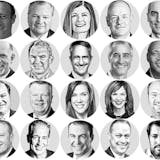As the Democratic presidential candidates prepare to debate again Wednesday, Andrew Yang perhaps will be the most surprising entrant. Yang's persistence has puzzled observers of the presidential race. Why hasn't "random man" — the quirky candidate with no political experience and no obvious qualifications — simply faded away long before now? How is he regularly besting senators and governors in the polls?
Surely, some of this is the Trump effect — a novel, meme-based candidate whom disaffected voters are primed to take seriously. But a better way to understand Yang is through the intrinsic appeal of his signature idea: the "freedom dividend." Gimmicky at first look, the concept of the freedom dividend has a long history in American politics on both the left and right. Its return during a time of political turbulence is unsurprising. In its essence, the freedom dividend is an idea whose time has come and gone and, with Yang's rise, come again.
What is the freedom dividend? Yang describes it as $1,000 a month, provided to every American citizen, no strings attached. His website calls it "a foundation on which a stable, prosperous, and just society can be built." In the second Democratic debate, he offered a pilot version of the program to 10 American families, setting off giggles and eye rolls from his rivals — but generating hundreds of thousands of entries on his website.
Yet while the name freedom dividend is new, the concept is old, with numerous versions around the world. Its most direct American antecedent is the negative income tax (NIT), the policy darling of liberals and conservatives alike in the 1960s. Like the freedom dividend, the NIT was designed to set a floor under U.S. workers. Instead of paying taxes, individuals and couples with income below a predetermined level would receive a cash payout from the Treasury. The amount would be reduced as income rose, eventually being phased out when an individual's income rises to a certain level.
Among the NIT's most famous supporters were libertarian economists Milton and Rose Friedman, who popularized the idea in their bestselling book "Capitalism and Freedom." "If funds are to be used to help the poor, would they not be used more effectively by being given in cash rather than in kind?" the two economists asked. But NIT was far from a right-wing idea. Friedman first hit upon the concept in discussions with Gunnar Myrdal, a Swedish economist. In the 1960s, the NIT was widely supported by Great Society liberals as part of the War on Poverty.
The NIT was a radical break with established thinking about the poor. For centuries, American charities and government agencies alike had divided the poor into the categories of "deserving" and "undeserving." The NIT proposed a different metric: the amount of income earned by an individual or family.
It was a stark and unemotional idea, based on numbers rather than moral judgment. It was not surprising that it was the libertarian Friedman, a devotee of individual freedom, who pushed this point the hardest. While debating the topic, Friedman charged that the then-welfare system involved an "intolerable degree of paternalism," transforming social workers into "police officers and spies." Friedman also went further than most in suggesting that the NIT could eventually supplant the established welfare state.
Other supporters of an NIT were driven by fears that machines were coming for U.S. jobs and would create mass unemployment. An NIT or other form of guaranteed income would be necessary for those who could not find work. "Because of the onslaught of automation, class boundaries are becoming more rigid," worried one college student writing at the time. In many ways, these fears were well-founded. Automation, driven by wartime advances in manufacturing, rapidly hollowed out places such as Detroit. The NIT promised to support those left behind by the first wave of automation at a time when unemployment seemed to portend a powder keg. In 1967, Detroit's unemployed sent the city up in flames during a three-day riot that had to be quelled by the National Guard.


